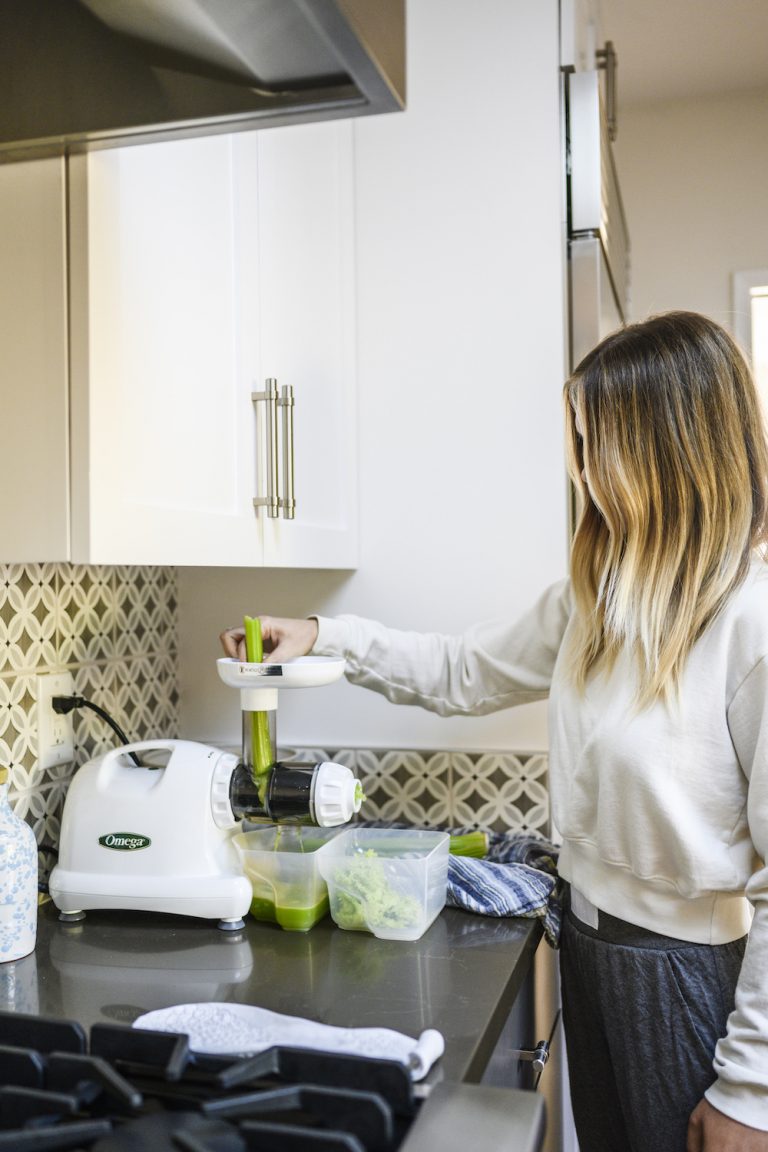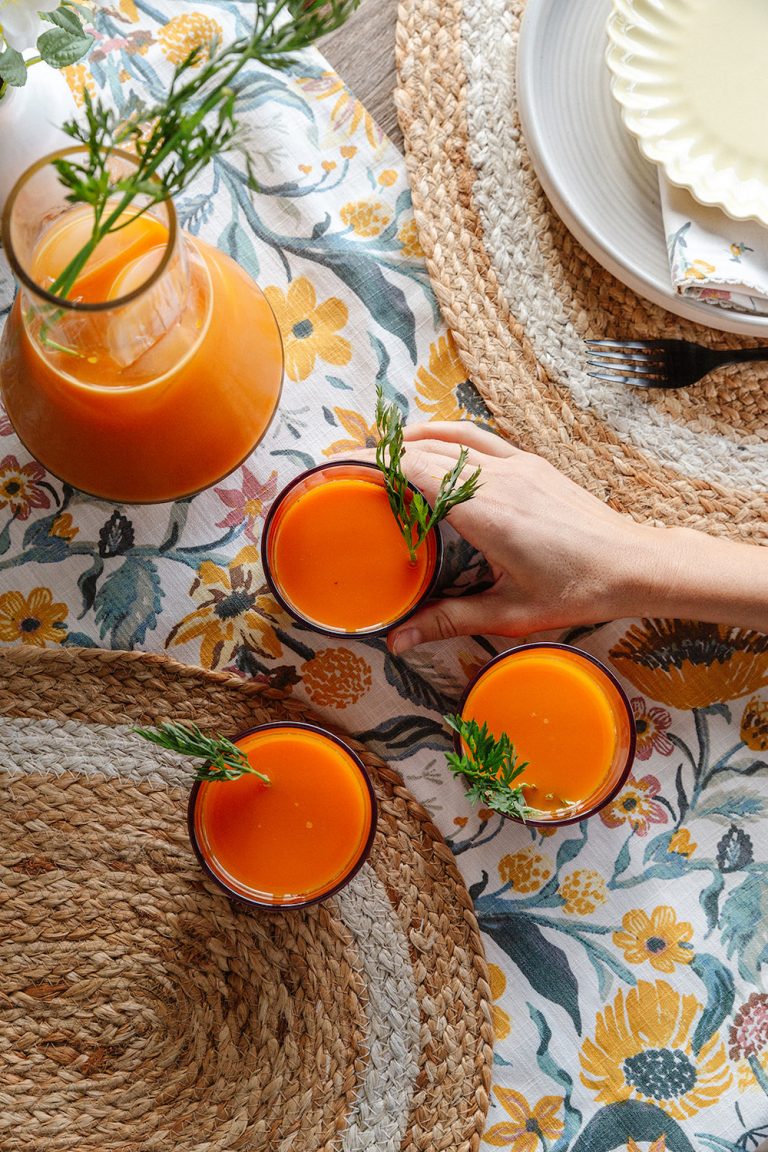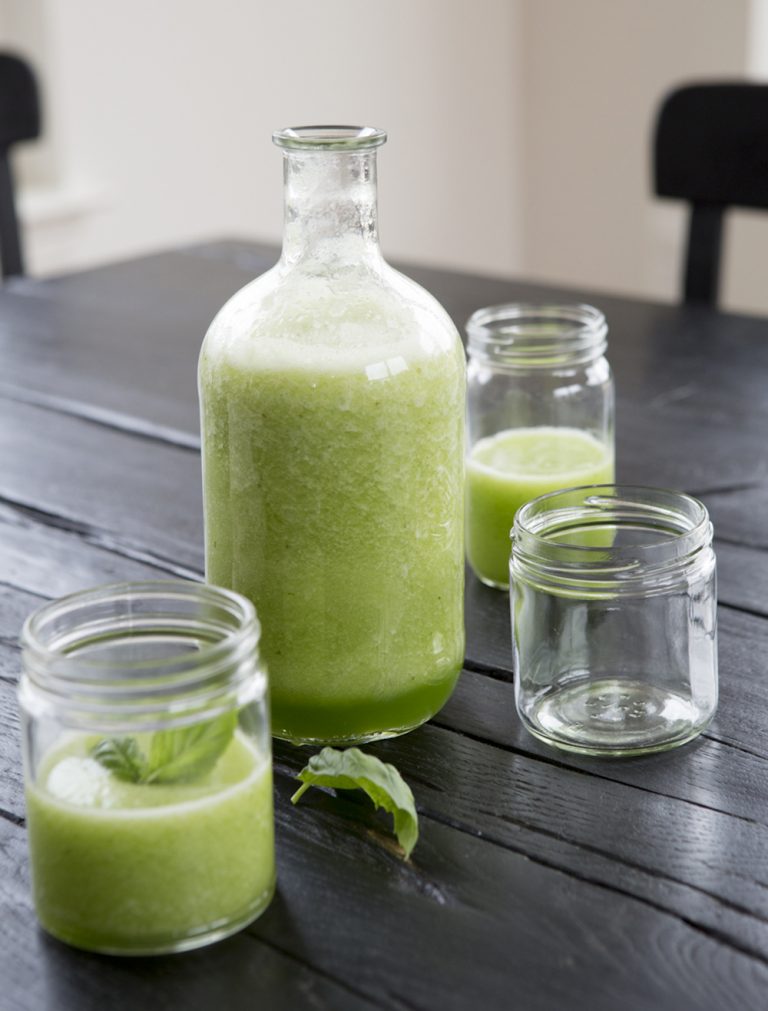A Nutritionist Shares 10 High-Energy Juice Recipes to Take Your Health to the Next Level
Maybe you clicked on this article because it’s almost the new year. And we know that January and juice cleanse go hand-in-hand (for better or for worse). Otherwise, maybe you’re feeling a bit sluggish. Hello, holiday baking. And while you’ve balked at juicing in the past, you’re taking a health-forward approach to 2022. Simultaneously, you’re skeptical. Do you need an expensive juicer? Is a three-day, healthy juice cleanse the only way to reap its rewards? Spoiler alert: No and no. We’re here to give you all the deets. Sipping on a green juice isn’t just a that girl thing to do—it’s more than a wellness trend. From which produce to use, to juice recipes for energy, get ready to take your health to the next level. New Year, New You.
What Is Juicing?
Juicing extracts liquids from fresh fruits and vegetables. While it strips away most of the solid matter—including seeds, pulp, and thin peels (like apples and grapes)—what’s left behind is liquid gold. Juice contains most of the micronutrients found in whole, unprocessed produce. Think: Vitamins, minerals, and phytonutrients. However, most of the fiber is lost during juicing. More on that, below.
We all know that juicing is good for our overall health. Produce—in general—is good for our health. Eating the rainbow, loading up on antioxidants (abundant in juice-friendly fruits and veggies!), and eating produce in season supports every cell in our body. But to get the most bang for your buck, most experts say to eat fruits and veggies in their whole, un-juiced form. However, there are still plenty of reasons to juice your fruits and veggies.

What Are the Health Benefits of Juicing?
When produce is juiced, you’re consuming an increased amount of fruits and vegetables (thus crowding out inflammatory foods), absorbing a high concentration of nutrients per ounce, and you’re giving your digestive system a break. Research shows that when abstaining from other solid food, vegetable and fruit juices provide essential nutrients. One study also shows a decrease in body weight and increase in healthy gut bacteria.
Ultimately, juicing is an effective and easy way to meet your daily quota for essential vitamins, minerals, and other valuable cancer-fighting nutrients. Fruit and veggie juices supply antioxidant nutrients like vitamin C and beta-carotene—both important for boosting immunity and protecting against oxidative stress. Plus, juicing can help with lowering blood pressure. In part, because raw foods contain potassium, and potassium maintenance is crucial for lowering blood pressure. Of course, consistent juicing can also lead to healthy weight loss, provide the body with energy, and increase potent antioxidants to aid in performance and overall health.
Juicing to Cleanse or Supplement
Generally speaking, juicing is used for two purposes:
- Cleansing. Solid food is eliminated and only juice is consumed for a set time period (3 days to several weeks). There isn’t any solid scientific evidence to support toxin removal from juicing, but it can help your liver’s ability to do its job (detoxify).
- Supplementing a normal diet. Fresh juice can be used as a handy supplement to your daily diet, increasing nutrient intake from fruits and vegetables that you wouldn’t otherwise consume. If you have difficulty stomaching ingredients like kale and celery, juicing them with sweeter fruits, like apples and pears, can help.
Juice Cleanses Aren’t for Everyone
Despite my passion for health and wellness, I don’t do liquid diets or juice fasts. These things are not for me—personally. Do I feel more energized after drinking a healthy juice? Absolutely. Am I quick to order a green juice at our local grocery if I need a pick-me-up? Yes. However, this is a reminder that we’re all bio-individuals. Meaning: You have unique nutritional needs, circumstances, lifestyle preferences, and accessibility. All of these factors contribute to how you take care of yourself. And taking care of your mental and physical health requires tapping into what makes you feel your best.
Everyday wellness is more than just a fad diet, buying expensive adaptogens, cutting out entire food groups, fasting until noon, etc. (unless, of course, these things bring you joy and make you feel good!). If doing a juice cleanse makes you miserable, retract to orthorexic tendencies, or elicit strong feelings of deprivation, know that juicing isn’t not all or nothing. You can take a realistic approach.

Benefits of Juicing One Meal a Day
Start by making one healthy, delicious juice recipe per week. In the morning or afternoon, try various healthy juice recipes for energy. Eventually, work your way to juicing one snack or meal a day—if it calls to you! Speaking of juicing one meal a day, this study shows that daily juicing lowers the risk factors for major chronic diseases, like heart disease and high blood pressure. Juicing, with vegetables and fruits, lowered cardiovascular risk factors, such as blood pressure and blood lipid profile.
Beyond the health benefits, juicing is quick, easy, and can be made in one batch (meal prep). As this author states, “I prefer to make all mine in one batch on the weekend so I don’t have to think about it for the rest of the week. I then break them down by portion into freezer bags, throw them in the freezer and take them out the night before as required.” Juicing one meal a day can swiftly become a way of life—a habit that tastes as good as it looks.
Do’s and Don’ts of Juicing
Opt for a 1:1 ratio to ensure that you have a good blend of vitamins and minerals. Furthermore, pick a colorful variety of non-starchy fruits and vegetables that are nutrient-dense, such as dark green leafy greens (spinach and kale) and tropical produce (mango and kiwi).
Also, keep the pulp! Fruits and vegetables are an incredible source of fiber, but it’s all in the pulp and skin. And juicing removes both, unfortunately. Also when possible, drink your juice right away. As your juice sits, it loses the antioxidants that prevent contamination. If you can’t drink your juice right away, refrigerate it (24 hours, tops) or freeze it (three months). Just make sure to check it before drinking. Don’t drink your juice if it no longer looks fresh or the mixture has separated, it may be teeming with harmful bacteria. Last but not least, be mindful of consuming fresh juice when pregnant.

The Best Fruits and Vegetables for Juicing
Juicing (especially healthy juice recipes for energy!) can be a convenient way to get the nutrients your body needs. But, you want to be mindful of what you put in your blender or juicer. If you want juice recipes for energy—that won’t send your blood sugar soaring—you’ll want to drink more than just pure pineapple or watermelon juice. While those fruits may taste better, they also may have more calories and sugar than vegetables. While taste preferences vary and produce is seasonal, these are universal fruits and vegetables for juicing:
Apples: Easy to find at the grocery store, apples are deliciously sweet and contain anti-inflammatory properties. They also contain pectin, which promotes good bacteria for the gut.
Beets: A sweet, earthy root vegetable, beets contain nitrates which can help increase blood flow.
Carrots: Another sweet vegetable, carrots improve eye health and are rich in vitamins and minerals, like biotin and vitamin A.
Celery: Hydrating and nourishing, celery has been known to help skin woes, supports digestion, and reduces inflammation.
Cilantro: A potent herb, cilantro raises energy levels and helps clear skin.
Cucumber: Water-rich, cucumber contains antioxidants and tastes mild in juices. It’s also known to help with liver and kidney function.
Ginger: Slightly peppery and sweet, ginger can help reduce inflammation, soothe digestive issues, and enhance immune function.
Kale: A powerhouse of nutrients, kale contains high levels of Vitamin K, calcium, antioxidants, and more.
Lemon: Packed with essential nutrients, lemons provide a tart, acidic flavor to healthy juice recipes.
Oranges: Citrus fruits, in general, are known to support immunity. Loaded with vitamin C and antioxidants, citrus might help protect against cancer.
Spinach: Spinach juice is high in antioxidants and beneficial compounds that may protect your vision, decrease blood pressure, and improve hair and skin health.
Turmeric: Packed with antioxidants, anti-inflammatory agents, and healing compounds, turmeric is healing for the whole body. Added to juices on a regular basis, it can soothe joint pains by reducing inflammation.

What Fruits and Vegetables Should You Use When Juicing for Energy?
Generally speaking, our bodies can quickly absorb all fruit juices. We use the natural sugars and micronutrients for an instant boost. When it comes to juice recipes for energy, specifically, there’s a variety of produce to incorporate (while eating these solid foods, too!):
Beets: Beets are rich in natural chemicals called nitrates. Through a chain reaction, your body changes nitrates into nitric oxide, which helps with blood flow. Because of this, plus its natural sugars, beet juice may boost stamina and energy.
Carrots: Once cup of carrot juice contains roughly 9 grams of the sugar, which the body can immediately metabolize for energy.
Celery: Juicing celery regularly may help boost energy levels, balance hormones, reduce inflammation, and alleviate skin issues (like acne, psoriasis and eczema) and many other symptoms.
Ginger: An energy-booster and mood-enhancer, by improving blood circulation and increasing metabolism, ginger can give you more energy. Plus, if ginger can improve digestion, your metabolism will improve and energy will be more available.
Green Apples: Juicing apples will supply a steady supply of glucose to your brain and muscles (for at least an hour or so). Green apples, specifically, are tarte and refreshing.
Kiwi: Drinking fresh kiwi juice delivers vitamin B and C, as well as potassium. These life-enriching nutrients contribute to increased energy, stamina and muscle recovery.
Oranges: A single cup can provide more than 100% of the body’s daily needs for vitamin C. It also provides about 10% of the daily carbs from sugars, which gives the body an energy boost. Citrus, as a whole, can increase energy and vitality.
Pineapple: A delicious energy-booster, pineapple contains natural sugars, vitamin C, and vitamin B1 to boost your metabolism, energy, and overall wellness.
Juicing Methods
Juicing methods vary, from squeezing fruit by hand to motor-driven juicers, to using a high-powered blender and squeezing out the pulp by hand. Two common types of juicers include:
- Centrifugal. These juicers grind fruits and vegetables into pulp through a high-speed spinning action with a cutting blade. The spinning also separates the juice from the solids.
- Cold-press. Also called masticating juicers, these crush and press fruits and vegetables much more slowly to obtain as much juice as possible.
Keep in mind that the nutritional quality of juice obtained from centrifugal and cold-press juicers is similar!
The 5 Best Blenders for Juicing
Ready to make healthy juice recipes for energy? Take a look at these five juicers, varying in functionality, size, and price.
Glad you asked. No need to toss or compost it. You can freeze your leftover juice pulp in small trays, add it to soups, use it in veggie burgers, bake bread or muffins, or make crackers. You can even convert it into a dip. See here for more ideas. Sky’s the limit.
10 Juice Recipes for Overall Health Energy, Digestion, Immunity, and More
When it comes to healthy juice recipes for energy, digestion, immunity, glowing skin, and more, look no further than the recipes below. These are equal parts flavorful and functional. The best of both worlds.
Green Machine
1 large bunch kale
Small bunch mint leaves
1 lime, peeled
2 kiwi, peeled
4 celery stalks
1 large cucumber
Light and refreshing, this healthy juice is slightly sweet and packed with phytonutrients.
Mother Earth
4 romaine leaves
1 large carrot
1 lemon, peeled
1 cup red grapes
1/2 large cucumber
6 stalks celery
A celebration of what grows below and above the ground, this juice recipe is hydrating and zesty.
Afternoon Pick-Me-Up
1 cup raspberries
1/2 pineapple, peeled and cored
1/2 lemon, peeled
1 cup spinach
1 knob ginger
When the afternoon slump hits, make this pick-me-up juice. Sweet and slightly spicy, it’s the energy boost you didn’t know you needed.
Antioxidant Power
1 beet, trimmed and halved
2 large carrots, trimmed
1 cup red grapes
1 cup blueberries
1 knob ginger
1 inch turmeric
To help decrease inflammation and boost antioxidants, drink this deep purple juice for energy and vitality.
Good Morning, Sunshine
1 orange, peeled
2 bell peppers (any color), halved and de-seeded
10 strawberries
3 large carrots
1 green apple
1 small bunch parsley
Swap your extra cup of coffee for this morning healthy juice. Packed with vitamin C, natural sugars, and detoxifying parsley, it’s the the best morning juice.
Hydrating Greens
1 cup spinach
1 large cucumber
3 stalks celery
1 small apple
1 lemon, peeled
Small bunch mint leaves
Packed with hydrating produce, this juice is equal parts refreshing, minty, and revitalizing. This is a healthy juice recipe to drink on repeat.
Get Glowing
1 grapefruit, peeled
4 large carrots
1/2 large cucumber
1 small apple
1 lemon, peeled
1 knob ginger
Glow from the inside out with his antioxidant-packed healthy juice. Containing vitamins and minerals to aid in skin health, drink this juice for healthy, radiant skin.
Sight for Sore Eyes
8 large carrots
2 oranges
1 red bell pepper
1 cup spinach
1-inch turmeric
1 knob ginger
Support your vision with this healthy juice. Packed with vitamin C, E, and riboflavin, this deliciously sweet juice helps maintain eye health.
Spicy Pineapple Zinger
1/2 pineapple, peeled and cored
1/2 jalapeño, stem removed
1 large cucumber
4 romaine lettuce leaves
1 lime, peeled
1 knob ginger
This juice will give you a much needed boost in hydration and energy. Although it contains half of a jalapeño, it’s not particularly hot. The sweetness of the pineapple provides the perfect balance.
Digestive Aid
2 celery stalks
2 handfuls kale
2 green pears
4 romaine lettuce leaves
1 lemon, peeled
1 knob ginger
As the name suggestions, this healthy juice supports digestion and detox pathways. This juice improves gut health while loading up on vitamins, minerals, and antioxidants.
